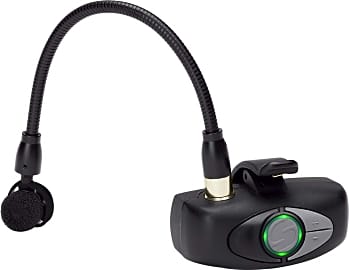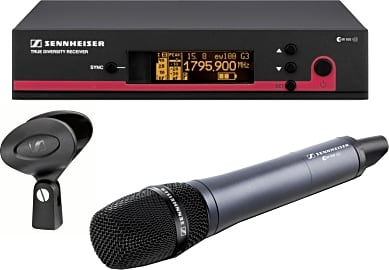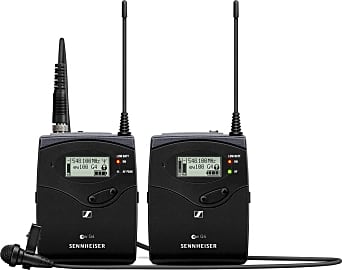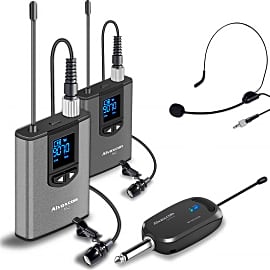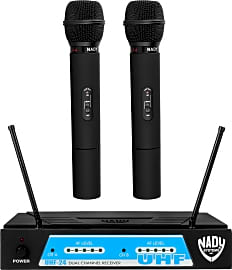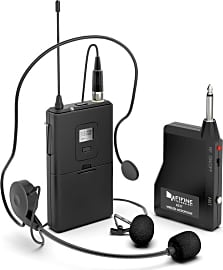The 10 Best Wireless Microphone Systems

This wiki has been updated 35 times since it was first published in October of 2016. Freedom of movement is important when performing or presenting live in front of an audience. Whether you're belting out a heartfelt solo to a packed house or delivering an inspiring sermon to a congregation, the last thing you need is a cable to trip over. With that in mind, we've compiled a diverse list of the most versatile and best sounding wireless microphone systems on the market. When users buy our independently chosen editorial recommendations, we may earn commissions to help fund the Wiki.
Editor's Notes
December 04, 2020:
This update saw a fair degree of turnover, as a couple models were discontinued by the manufacturer, while others were just replaced by items that performed better. Another noteworthy change to the market is that, as of July 2020, the FCC has declared that all microphones operating on the 600 MHz band will require special permissions. This means some transmitters had to be pulled or adjusted to meet these guidelines.
If you're looking for a handheld mic, the Shure BLX88 includes two reliable wireless mics and a powerful receiver that should give a strong signal for up to 300 feet. It also has a convenient feature that allows you to find the clearest channel to set the mics to with the push of a button. If you want something more affordable, the Nady UHF-24 is a fraction of the cost, and actually boasts a range of up to 500 feet in the right conditions. Note that neither of these systems comes with an XLR cable, so you'll need to purchase one in order to connect the receiver to your PA system.
If you're not in the market for a handheld mic, the Alvoxcon TG220 is a very affordable options that delivers great quality for the price, and includes both a lavalier mic and a headset. The Sennheiser EW 100 G4 comes with a receiver and a microphone of your choice, and with lavaliers, headsets, and several handhelds to choose from, it's probably the most versatile option. If you're a musician looking to amplify the sound of an acoustic instrument, the Samson Airline AWX has the microphone and transmitter in one solid piece that clips directly to your gear, and delivers good quality sound at a reasonable price. People looking to pick something up for video production will want to consider the Sennheiser EW 112P. The transmitter and receiver are each compact body packs that can be clipped to a belt, and the microphone can easily be hidden in clothes, and performs well enough to capture clear dialog without being directly in front of the subject's mouth. That said, do keep in mind that the preamp of your sound system or recording device will have a lot to do with sound quality, so purchasing a great microphone alone may not be the solution to all of your audio woes.
November 08, 2019:
There are plenty of handheld as well as clip-on mics available that are mated with high-performance wireless kits. The Shure BLX24R, Shure PGXD24, and Shure GLXD14 come from hands-down the most popular and well-known stage audio manufacturer, and they all very much live up to their manufacturer's reputation, though they are a touch expensive. One of the things they do well is mitigate interference, even when multiple microphones are in use simultaneously. Even more on the high end is anything by Sennheiser; we've highlighted their Sennheiser EW 145 pack here because it's about as nice of a set as most consumers will ever need.
You don't have to spend many hundreds to get a good system, though, as evidenced by the Nady UHF-24 and Nady MHT-16. The former is great for speakers and singers while the latter is intended to instrumentalists of all types. For even more affordable options, check out the Bietrun WXM01 and Kimafun 2.4G. They aren't ideal for music performance but they work just fine for many public speaking engagements.
One final company we wanted to highlight is Samson. The Samson SWAM2SES features a K-band earpiece-style transmitter with a beige finish and classy appearance that doesn't stand out nearly as much as a typical black headset. Meanwhile, the Samson Airline AWX is one of the very few instrument mics that clips to the horn and transmits directly to the base station without having to stop at a base station first. This not only increases a performer's flexibility, but it also greatly reduces the chance of damaging expensive electronics when instruments are moved around, switched out, or just set down for a song or two.
Special Honors
Sennheiser XSW-D XLR Base Set Already have a mic that you love, but need something wireless for an upcoming event? Check out this package that allows you to transform anything with an XLR port into a wireless device. It has a range of up to 250 feet and a battery life of up to 5 hours, so it should be great for just about any gig that comes up. sennheiser.com
Live Performance: There's Nothing Like It
Something must come to the rescue of all these boundless performers.
Music is one of our world's universal languages. The experience of live art is one that almost every human has enjoyed on some level. Whether it's ceremonial dancing around a campfire in the African plains or Justin Beiber prancing around an LED-covered stage, live music has a strong emotional pull on every person.
Technology, of course, has found its way into so many aspects of our lives. The presentation of art is certainly not exempt from this. New concepts in engineering have allowed artists to express themselves in truly cutting-edge ways, and this includes the technologies used to deliver live audio in performance settings. Specifically, advances in wireless microphones have increased the abilities of actors, musicians, and athletes to ply their trades and put on a good show.
After all, Mr. Beiber can't be bothered to lug a handheld mic across the stage as he croons lovingly to his shrieking, pubescent fans. And the famous Marsalis Brothers will, of course, not be bound by any earthly audio cable while soaring to the stratosphere on their jumping hip-hop or classical jazz melodies. For that matter, the cast of the Lion King simply cannot physically plug in, not when they must dance around on stage like gazelles.
Something must come to the rescue of all these boundless performers. And that thing is high-frequency, FM-modulated wireless microphone technology.
What A Difference A Wire Makes
At first glance, it might not seem like such a big deal that a singer's mic is necessarily attached to a wire. If the cable is long enough, and the connectors are of a high enough quality, anyone on stage should have no problem maneuvering around the set without destroying plugs or distorting sound, right? Well, there are a lot of situations where that's not the case.
When two standard audio cables or their connectors come into contact, there can be a bleed-over that causes an audible distortion or hum in the sound.
First off, when a band hits the stage, there are a lot of different cables in play. Obviously, the more cords involved, the greater the tripping hazard. Since part of the job of a lead singer is often to jump around like David Lee Roth while avoiding pyrotechnics, he or she could need a considerable amount of freedom to really let loose. The same could be said for a trumpet or trombone player who may, for example, wish to crowd-surf during a big solo.
There are benefits to wire-free audio beyond just not tripping over an extra cable or having a limited range of motion. When two standard audio cables or their connectors come into contact, there can be a bleed-over that causes an audible distortion or hum in the sound. A wireless system allows for what's called galvanic isolation, effectively eliminating this problem.
Because a standard mic cable carries an analog signal, the quality can degrade over the length of the wire even if it's not receiving interference from other electrical devices. Some wireless options are fully digital, from audio collection all the way to data transfer. These advanced systems ensure that the audio signal at the receiver is of a high fidelity and identical to the source.
Aside from freedom of movement and signal clarity, the lack of a cable between mic and amplifier helps to create a cleaner visual presentation, great for television broadcasts and video blogs. Fewer cords snaking around the floor means less clutter and a more immersive theater or musical experience — it's just good showmanship.
How They Work and What They Do
The versatility of wireless microphones is exemplified by the different varieties offered. Handheld models are pretty straightforward. They may have a slightly larger body compared to a standard, corded option in order to house the wireless transmitter. Overall, they're pretty interchangeable replacements and they fit in most available mic clips just like any other microphone.
One interesting use of wireless technology is in adapters made for older, corded units. These plug directly into the XLR port on a normally wired mic and are a great way to introduce attractive and unique pieces to your stage setup, such as specialty vintage microphones that otherwise aren't available in wireless configurations. And they're great investments because they can be used with different mics to suit your changing needs.
True diversity uses two or more individual receivers in separate locations to read the transmitted signal and then compares and matches those streams.
Bodypack setups are somewhat more specialized towards live stage or athletic events. Because they keep the user's hands free, they're great for performances that require a wide range of motion. These generally consist of headset, earpiece, or clip-on mics that connect to a small box worn on the body, often on the belt.
Wireless performance audio isn't without its issues. Interference from various sources is possible, as are dead spots due to range limitations and physical blockages on stage. A concept called diversity is an effective way to combat this. True diversity uses two or more individual receivers in separate locations to read the transmitted signal and then compares and matches those streams. This greatly reduces dead spots, as well as the phase shift that occurs thanks to different audio frequencies traveling at different speeds.
Companding is another process used to fight interference. The audio data is compressed before transmission so that it occupies a smaller range of frequencies, and then expanded when it arrives at the head unit. This lowers the chance that the signal will have to share the airwaves, thus preventing distortion.
Quality models will have selectable and dynamic frequencies, so you can select the right wavelengths based on the stage setup, number of wireless units, and available channels. Some advanced choices are programmed to automatically select the most effective ranges and avoid those that are clogged, making them perfect for productions with lots of cast and crew.
So, it's important to make sure your equipment is right for the job. Performers across the board, whether they're instrumentalists, singers, head coaches, or actors, appreciate the versatility, sound quality, and ease-of-use of today's leading wireless microphone systems.




